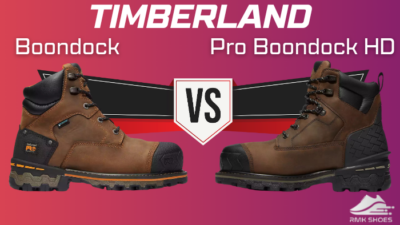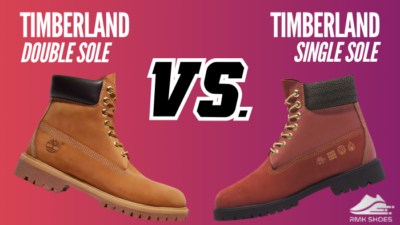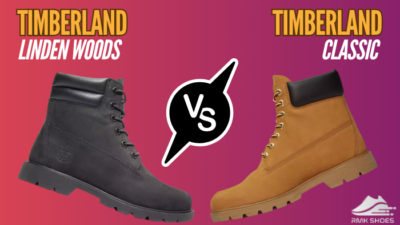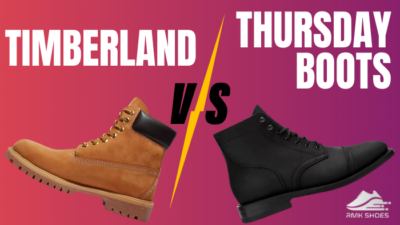If you are looking for running shoes, several brands offer various models with unique characteristics.
Nike Pegasus and Mizuno Wave Rider are two popular running shoe series. They provide high-quality shoes to enhance the running experience.
However, there are some differences in design, comfort, performance, and durability.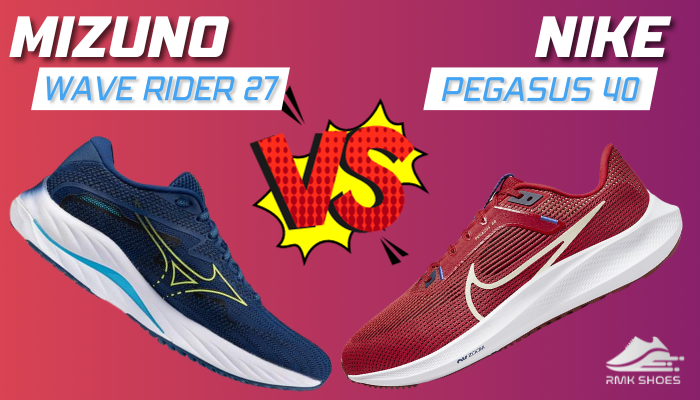
So, I will provide a detailed analysis of the Nike Pegasus 40 and Mizuno Wave Rider 27 to select the perfect running companion.
Let’s jump in.
Overview of Nike Pegasus and Mizuno Wave Rider
Nike introduced the Pegasus lineup back in 1983. The series has had various performance improvements over the decades, and the Nike Pegasus 40 is its last outcome.
The latest version, Pegasus 40, released in 2023, is a well-rounded daily trainer for short and faster runs. The breathable upper, durable outsole and stable feel make it a comfort king, a top choice among runners.
Mizuno Wave Rider started its journey in 1998.
Over the 25 years, there have been several changes and improvements in the series in pursuit of perfection.
The signature wave plate to stiffen the heel since day one is still present in today’s Mizuno Wave Rider 27, which was released in 2023. The Enerzy foam used in the midsole offers ample cushioning without feeling mushy.
Though it has a slightly higher heel drop, it is a dependable and stable workhorse shoe for various distances.
Attribute Comparison of Mizuno Wave Rider 27 and Nike Pegasus 40
There are numerous models and series for running shoes, so finding a perfect pair of shoes feels like searching for a needle in a haystack.
Mizuno Wave Rider has 27, and Nike Pegasus alone has 40 models, which is a head-scratcher.
As there are many models, I will make head-to-head comparisons in a table highlighting the key attributes of the Nike Pegasus 40 and Mizuno Wave Rider 27 that I’m currently using.
Following is the attribute comparison table between Mizuno Wave Rider 27 and Nike Pegasus 40:
| Attributes | Mizuno Wave Rider 27 | Nike Pegasus 40 |
|---|---|---|
| Upper | Jacquard mesh | Engineered mesh |
| Outsole | X10 blown rubber | Duralon blown rubber |
| Midsole | Mizuno Enerzy foam with Pebax Wave Plate | React foam with Zoom Air unit |
| Cushioning Softness | Firm | Balanced |
| Breathability | Good | Below Average |
| Stack Height (Approx.) | Heel: 38.5 mm, Forefoot: 26.5 mm | Heel: 33 mm, Forefoot: 23 mm |
| Heel-to-Toe Drop | ~12 mm | ~10 mm |
| Weight | ~9.9 ounces (Men 9) | ~9.4 ounces (Men 9) |
| Fit | True-to-Size | True-to-Size |
| Reflective Elements | Yes | Yes |
| Heel Tab | None | None |
| Price | ~$140 | ~$130 |
| Best for | Daily training, long runs | Daily training, short runs |
Let’s jump into the detailed comparisons.
Key Differences Between Nike Pegasus 40 and Mizuno Wave Rider 27
While both are running shoes, the Nike Pegasus 40 and Mizuno Wave Rider 27 differ in weight, upper, sole, cushioning, etc.
Here are the differences between the Nike Pegasus 40 and Mizuno Wave Rider 27:
1. Upper Constructions
Both shoes look great and appealing. Though they both are running shoes, some dissimilarities in material, tongue, etc., can make or break the deal.
Upper
Pegasus 40 received the most significant changes from its predecessor on the upper. The shoe features a softer and breathable single-layer mesh material in the upper.
The roomy toe box and snug fit are really appreciated.
This shoe offers a blend of loved things that were present in the older shoes.
For example, v36’s soft material feel, midfoot lockdown of versions 37 & 38, and the padded tongue of 39 are all included in the Pegasus 40 upper.
I hesitated about the lockdown due to the parallel horizontal laces, but it was not an issue. Instead, it was a close fit.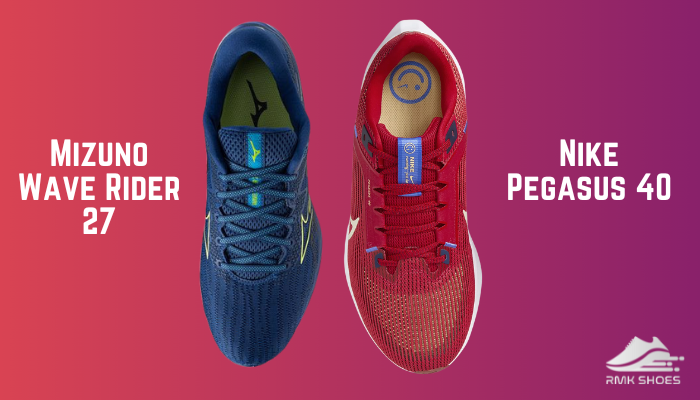
On the other hand, Mizuno changed the upper from v26, and in v27, they used an engineered Jacquard mesh upper.
The soft and flexible upper is well-designed.
I found the traditional X-layout lacing system offers a secure midfoot lockdown without having to double-knot.
The well-padded heel was also great for a snug, rub-free fit.
Tongue
Pegasus 40 and Wave Rider 27 both have gusseted tongues.
While Peg 40 uses a full-gusseted tongue, Wave Rider 27 features a semi-gusseted tongue.
| Parameter | Nike Pegasus 40 | Mizuno Wave Rider 27 |
|---|---|---|
| Tongue-gusset type | Full-gusseted | Semi-gusseted |
I love having a guessed tongue, and Nike & Mizuno are generous enough to provide one despite their prices.
Heel Tab
There are no heel tabs on the Wave Rider 27 or Pegasus 40.
However, I didn’t feel it was necessary for any of these shoes.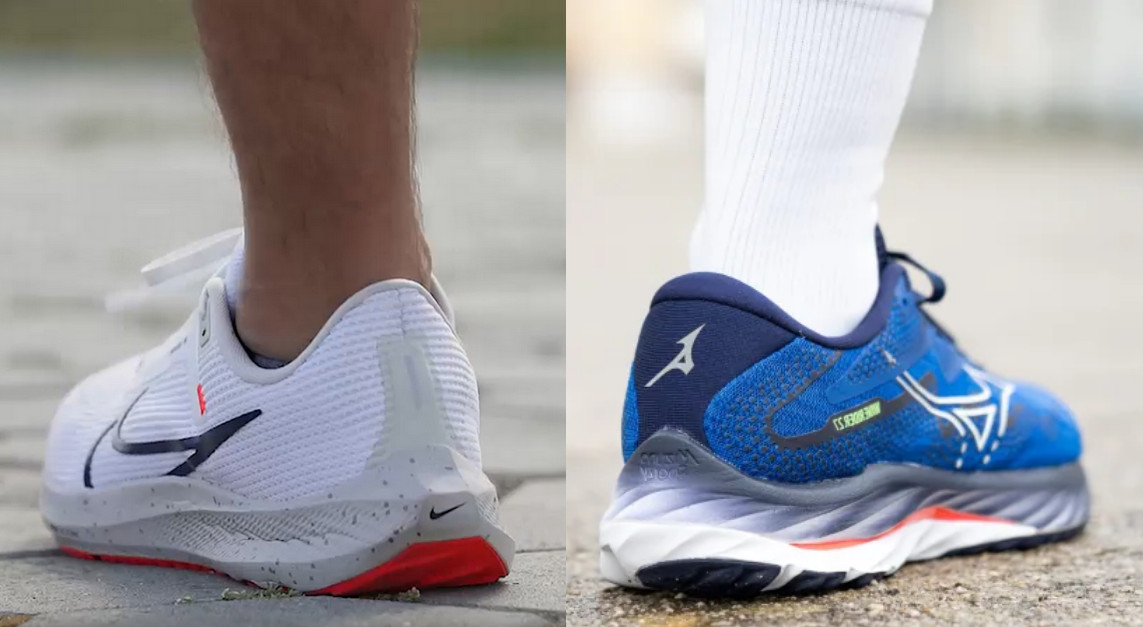
Both trainers are hassle-free to put on.
Regarding upper construction, when Pegasus shines in one factor, Wave Rider glows in another. So, I say they are a tie here.
2. Design and Aesthetics
Color
Nike takes the lead when it comes to color appearance.
There is a limited color collection for Wave Rider 27.
But, besides a more extensive variety of color choices, you can customize and design your own shoes with the Nike Pegasus 40.
Reflective Elements
Usually, such budget-friendly footgears don’t come with any reflective elements.
However, both Wave Rider 27 and Pegasus 40 have a small reflective part back on the heel.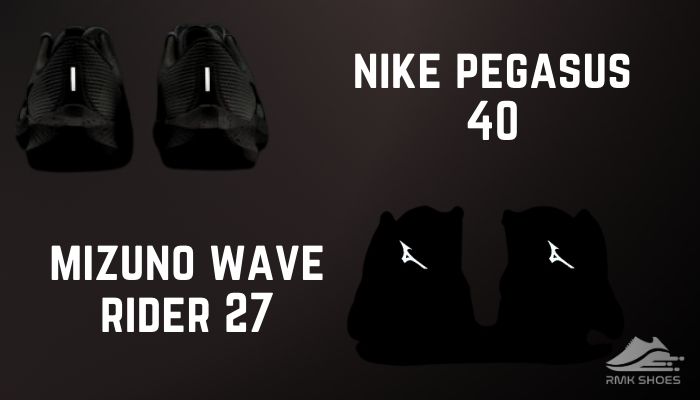
Mizuno made an intelligent move here, as the lighting-up thing is actually their logo!
3. Breathability
The Pegasus 40’s upper is perforated enough, which led me to think it would be great in terms of breathability.
But as the proverb says, all that glitters is not gold. Similarly, I was not satisfied with 40’s breathability, which was much better in version 39.
If I have to rate the ventilation, it is 3.5/5.0 for the warm and less airy feel.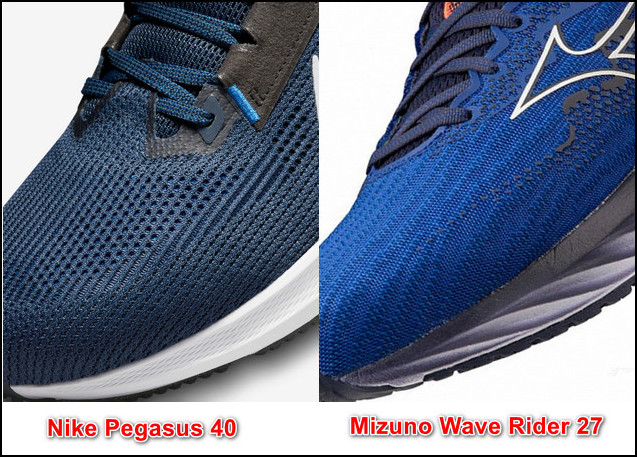
In contrast, Wave Rider’s jacquard mesh upper is better regarding breathability. Though it’s not excellent, it is good, and I can give a 4.0/5.0 rating to it.
Why?
Limited ventilation holes dampen the jacquard mesh’s breathability potential.
Moreover, thanks to Mizuno, they didn’t add extra fabric inside the upper, which would hinder the airflow even more.
| Shoe | Breathability | Rating |
|---|---|---|
| Nike Pegasus 40 | Mediocre | 3/5 |
| Mizuno Wave Rider 27 | Better | 4/5 |
4. Sole Technology
Soles make contact with the ground and play a crucial role in protecting your feet. So, what technology shoemakers offer impacts the overall ride experience.
Outsole Design and Traction
The Nike Pegasus 40 features an outsole with Duralon blown rubber on the upfront and harder BRS 1000 in the heel. The combination maintains durability and provides excellent grip on sidewalks and roads.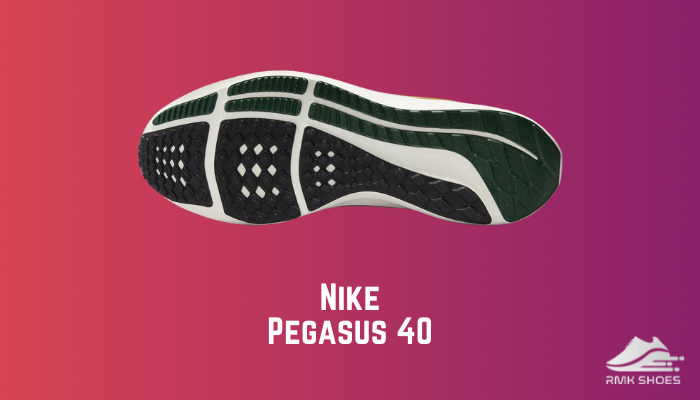
Though the waffle-patterned tread was great on dry surfaces, I didn’t feel confident on wet concrete.
Moreover, you can use them on light trails, but I wouldn’t recommend them. Instead, you should use Nike Air Zoom Terra Kiger 8 or Pegasus Trail 4.
Conversely, the Mizuno Wave Rider 27 features a thick layer of XT10 carbon rubber in its outsole.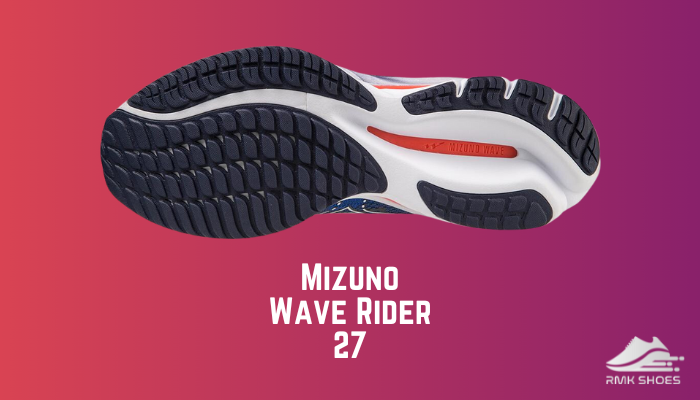
In my test, it provided a good grip on dry or wet surfaces. It’s ready to tackle dirt paths and light trails with a comfortable ride.
Midsole Construction
The midsole takes care of the bump. Shoe manufacturers show the magic here when it comes to cushioning and shock absorption.
Pegasus 40 features two Air Zoom units embedded within its durable TPE-based React foam.
I expected to have Pebax-based ZoomX foam for a more responsive and plush cushioning, as React has been there since Pegasus version 37.
Though the current React foam doesn’t offer the crazy bounciness of ZoomX, it does offer a plush feel.
Meanwhile, Mizuno used Wave Plate technology, offering a blend of comfort and stability. The Wave Plate helps distribute impact forces evenly and provides a smooth ride.
Mizuno’s Enerzy Foam is also in the midsole, similar to version 26.
It’s not overly soft, but it doesn’t feel like a rock, either.
Both shoes have an insole removal option. The removable insole allows you to easily replace it with custom orthotics or a preferred insole from other shoes.
I prefer Wave Rider 27 more than the Pegasus for the sole offerings.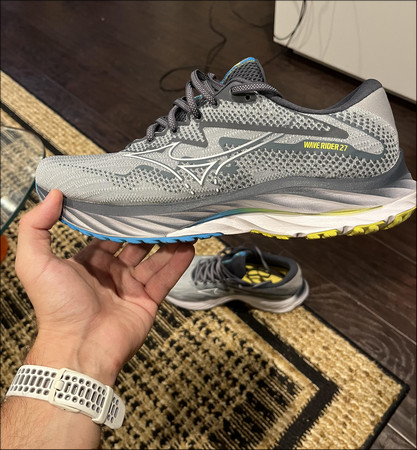
5. Comfort, Fit, and Sizing
Pegasus 40 has a well-padded tongue and heel collar. Though the tongue feels slightly thinner than the v39, it is more padded than average shoes.
The Nike Pegasus 40 fits true-to-size for me.
The toe box has an ample room, which feels broader than its predecessor. However, the heel side is typically narrow.
The lacing system provides an effective midfoot lockdown and precise fit.
Conversely, Wave Rider 27 also offers a padded tongue but is less padded than the Peg 40.
I ordered size 9, and the shoe fits true-to-size.
The toe box is wide enough to suit most user’s feet comfortably. The toe box width at the big toe is also slightly broader than average.
| Shoe Name | Fit | Tongue padding |
|---|---|---|
| Nike Pegasus 40 | True-to-Size | ~8.5 mm |
| Mizuno Wave Rider 27 | True-to-Size | ~6.5 mm |
I found that the revised heel collar is slightly less padded and has no wider opening. With less wiggle room side-to-side, the new heel counter ensures a secure fit.
When it comes to comfort or fit, both shoes take the win.
6. Cushioning and Weight
Regarding cushioning, Pegasus 40 has around 33 mm stack height on the heel and 23 mm at the forefeet.
So, the cushioning delivers a plush and responsive feel, absorbing impact, and a drop of around 10 mm provides a smooth ride.
Peg 40 was excellent in flexibility. But, if you live in a freezing area, the midsole can stiffen quickly, which is terrible.
| Shoe Name | Heel Stack | Forefeet Stack | Drop | Weight |
|---|---|---|---|---|
| Nike Pegasus 40 | ~33mm | ~23mm | ~10mm | ~9.4 oz (Men 9) |
| Mizuno Wave Rider 27 | ~38.5mm | ~26.5mm | ~12mm | ~9.9 oz (Men 9) |
On the other hand, the Mizuno Wave Rider 27 features a stack height of 38.5 mm and 26.5 mm in the back and front, respectively.
This stack height results in a steep heel-to-toe drop of around 12mm. It’s a lovable thing for extreme heel strikers.
On top of that, the shoe can handle the cold weather pretty much without stiffening.
Regarding the heaviness, both are below 10 ounces.
While Mizuno is offering high cushioning with a bit of additional weight, Nike offers less weight with the cost of cushioning. So, they are a tie.
7. Stability and Durability
Stability
Pegasus 40 was stable for me. The lightweight helps stability and gives an enjoyable ride.
But for overpronators, it will be uncomfortable.
In terms of stability, Wave Rider 27 is amazingly stable as a daily trainer. Thanks to the Wave Plate, which makes a huge difference.
Durability
When it comes to durability, the Pegasus 40 is built like a tank.
The thick, dual-layered mesh in the toe box and the ~3.4mm outsole are exceptionally durable.
So, you won’t have to worry about the grip even after 400 miles, whether on roads or trails.
In contrast, Wave Rider 27’s upper is also durable but not amazing like the Pegasus. However, the heel padding and outsole durability are excellent.
Mizuno Wave Rider takes the crown for stability and Pegasus for durability.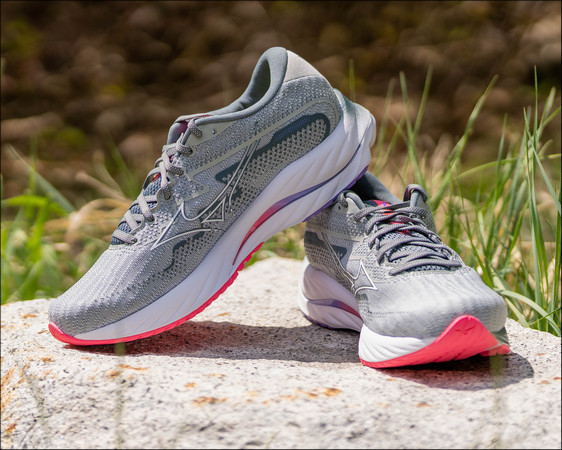
8. Price and Value
Now, let’s discuss everyone’s favorite topic – money!
Regarding the price, the Nike Pegasus 40 and Mizuno Wave Rider 27 cost a similar price range.
While the Peg 40 won’t break the bank and cost around $130, the Wave Rider 27 also comes with a pocket-friendly price of around $140.
But you can always look for an eye to get them on sale!
Regarding value, the shoes offer excellent performance and durability. It’s a good investment that will pay off in the long run. So, they are a value for money.
They both come at a similar price range and offer good value for bucks, so I call it a tie.
Pros & Cons of Nike Pegasus 40 and Mizuno Wave Rider 27
It’s a close call to pick one between the trusty Nike Pegasus 40 and the versatile Mizuno Wave Rider 27. Learning their strengths and weaknesses can help you make an informed decision.
Here are the advantages and disadvantages of the Nike Pegasus 40 and Mizuno Wave Rider 27:
Nike Pegasus 40
- »Soft and responsive cushioning.
- »Slightly lighter than Wave Rider 27.
- »Versatile and fit true to size.
- »Improved comfortable upper.
- »Durable outsole and great grip.
- »Stable ride with a good lockdown.
- »Sleek and modern design.
- »Less stable for overpronators.
- »Longer runs can be uncomfortable.
- »Lacks ZoomX foam.
- »Firm ride with little to no energy return.
Mizuno Wave Rider 27
- »Smooth and responsive ride.
- »Excellent stability.
- »Durable, comfortable, and versatile.
- »Great outsole grip and traction.
- »Best for heel strikers.
- »Plenty of cushioning for long runs.
- »90% recycled materials are used on the upper.
- »The higher drop is a drawback for forefoot strikers.
- »Slightly heavier than the Pegasus 40.
- »Cost higher than the Pegasus 40.
- »Average breathability.
Which to Choose: Mizuno Wave Rider 27 or Nike Pegasus 40?
Mizuno Wave Rider 27 impresses with its stability, comfort, and soles. It’s an excellent pick for more extended and slower runs.
Meanwhile, the Nike Pegasus 40 shines in its design, cushioning technology, responsiveness, and durability. It’s a perfect fit for shorter and faster runs.
Though the Wave Rider 27 costs $10 more than the Pegasus 40, I use the daily trainer as it gives me confidence and meets my requirements.
So, depending on your running style and preference, you can choose whichever fulfills your needs.
Both are great, and you can’t go wrong with either.
Happy running!
FAQs
Are the Mizuno Wave Rider 27 and Nike Pegasus 40 good for walking?
Though Pegasus 40 and Wave Rider 27 are designed primarily for running, you can use those on casual wear or walking. Their versatility and flexibility allow them for everyday use. However, for hiking or specific sports, they may not perform well.
How do the Nike Pegasus 40 and Mizuno Wave Rider 27 fit?
Both the Nike Pegasus 40 and Mizuno Wave Rider 27 generally run true to size and ensure a snug fit. For wider feet, both have wider width options.
What distance are Nike Pegasus 40 and Mizuno Wave Rider 27 best suited for?
The Nike Pegasus 40 is best for short-medium distance runs with a faster pace. The Mizuno Wave Rider 27 can handle daily training runs of various distances and is best suited for longer and slower runs.
What’s the difference between the Mizuno Wave Rider 26 and 27?
The Mizuno Wave Rider 27 is slightly lighter, suitable for long distances, and more stable than the Wave Rider 26. Moreover, the Wave Rider 27 has slightly more padding on the tongue and overall provides more comfort with a streamlined design.
Is Mizuno Wave Rider a neutral shoe?
Yes, the Mizuno Wave Rider is a neutral shoe, which is great for daily training. The shoes prioritize comfort and performance with ample cushioning and a responsive feel. The smooth and supportive rides help you achieve your fitness goal.
Why are Mizuno shoes so good?
Mizuno shoes are good for their high-quality materials, variety of options, and focus on comfort. Mizuno also incorporates recycled and sustainable materials into its shoes. Moreover, the innovative wave technology, durability, and good fit make them a top choice for runners.

